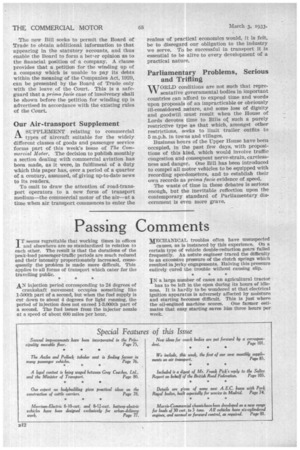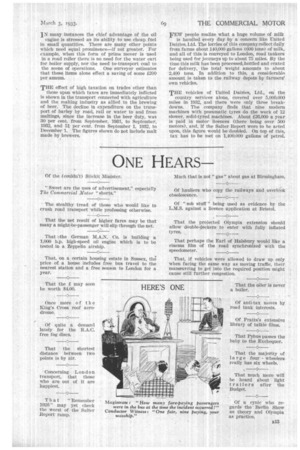Passing Comments
Page 30

Page 31

If you've noticed an error in this article please click here to report it so we can fix it.
TT seems regrettable that working times in offices
and elsewhere are so standardized in relation to each other. The result is that the durations of the peak-load passenger-traffic periods are much reduced and their intensity proportionately increased, consequently the problem is made more difficult. This applies to all forms of transport which cater for the travelling public.
AN injection period corresponding to 24 degrees of crankshaft movement occupies something like 1-500th part of a second, but when the fuel supply is cut down to about 4 degrees for light running, the period of injection does not exceed 1-3,000th part of a second. The fuel issues from the injector nozzle at a speed of about 600 miles per hour.
MECHANICAL troubles often have unsuspected causes, as is instanced by this experience. On a certain type of vehicle double-reduction gears failed frequently. An astute engineer traced the difficulty to an excessive pressure of the clutch springs which resulted in jerky engagements. Halving this pressure entirely cured the trouble without causing slip.
IN a large number of cases an agricultural tractor has to be left in the open during its hours of idleness. It is hardly to be wondered at that electrical ignition apparatus is adversely affected by moisture and starting becomes difficult. This is just where the oil-engined machine scores. One farmer estimates that easy starting saves him three hours per. week. IN many instances the chief advantage of the oil engine is stressed as its ability to use cheap fuel in small quantities. There are many other points which need equal prominence—if not greater. For example, when this form of prime mover is used in a road roller there isno need for the water cart for boiler supply, nor the need to' transport coal to the scene of operations. One surveyor estimates that these items alone effect a saving of some £200 Per annum.
THE effect of high taxation on trades other than
those upon which taxes are immediately inflicted is shown in the transport connected with agriculture and the malting industry as allied to the brewing of beer. The decline in e-xpenditure on the transport of barley by road, rail or water to and from maltings, since the increase in the beer duty, was 30 per cent. from September, 1931, to September, 1932, and 51 per ,cent. from September 1, 1932, to December 1. The figures shown do not include malt made by brewers. FEW people realize what a huge volume of milk
is handled every day by a concern like United Dairies, Ltd. The lorries of this company collect daily from farms about 140,000 gallons (600 tons) of milk, and all of this is conveyed to London, road tankers being used for journeys up to about 75 miles. By the time this milk has been processed, bottled and crated for delivery, the total weight amounts to about 2,400 tons. In addition to this, a considerable amount is taken to the railway depots by farmers' own vehicles.
THE vehicles of United Dairies, Ltd., on the
country services alone, covered over 5,000,000 miles in 1932, and there were only three breakdowns. The company finds that nine modern machines with pneumatic tyres do the work of 12 slower, solid-tyred machines. About £26,000 a year is paid in motor licences (there being over 500 motors), and, if the Salter Report were to be acted upon, this figure would be doubled. On top of this, tax has to be met on 1,400,000 gallons of petrol.




































































































